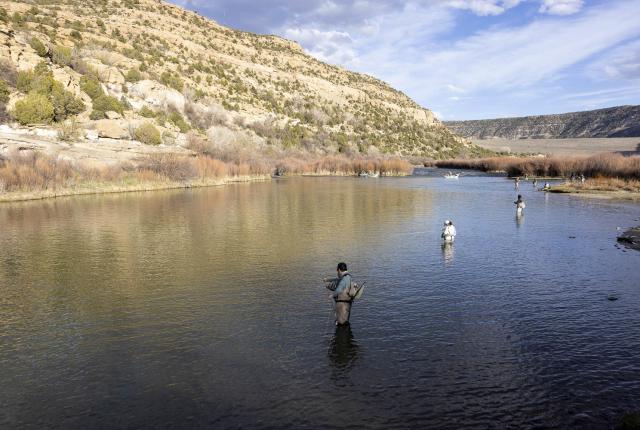HIGHWAY 511 WEAVES through hills and gullies into the small mountain community of Navajo Dam. Anglers from around the world travel here to cast for brown and rainbow trout that occupy this beautiful four-mile stretch of San Juan River, which runs between the dam and the town.
On a gray day in mid-March, dark clouds loom over the valley like mountains in the sky. It’s early in the season, but fly anglers are still out in force along the San Juan’s Quality Waters, which require the use of artificial flies, barbless hooks, and catch-and-release practices. Near the Texas Hole, an access point about 1.25 miles south of the dam, trails break away from the parking lot to the river, where anglers in waders and heavy jackets cast their hopes for one of the San Juan’s 20-inch beauties.
Spring’s silty waters create low visibility, so most anglers are using indicators—little white or colorful floats or flashy foam flies that act like bobbers—with a tiny nymph or egg pattern that runs underneath the water’s surface. Fishing here, whether wading or from a motorless drift boat, is tactical, precise, and absolutely exhilarating. Some surveys estimate the number of trout along this stretch at 15,000 per mile, but that doesn’t mean they’re easily caught. “These are smart fish,” says Jeff Massey, owner of Soaring Eagle Lodge and a fishing guide since 1991.
In conditions like these, the indicator may only stall or vibrate for a moment as the trout takes your tiny underwater fly into its mouth. “You react right now,” Massey says, “or you are not hooking that fish.”
Oh, but when you do. When the waters are clear, especially in July and November, the San Juan becomes a haven for dry fly-fishing, or what Massey calls the holy grail. Rising trout feed on the abundant insects coming downriver, but for fly-fishers, it takes timing, patience, and a ton of skill to get the presentation just right. “You’re watching the fish come to the surface, open its mouth, and draw in the insect that’s on the surface tension of the water,” he says.
Once you set the hook, “a big rush of adrenaline hits you,” says fly-fishing guide Tim Chavez, who grew up in Navajo Dam. And the trout? “A lot of times, they’ll just explode,” he says. As the fish takes off in a frantic attempt to get free, the angler must keep tension on the rod while letting the trout swim, until that four-pounder can be coaxed back toward the net without allowing the tiny barbless hook to wiggle loose.
When a hefty brown—speckled with dark pebblelike spots running along its thick copper sides, that fade to pale yellow at its belly—gets lifted from the chilly waters, it unlocks something fundamental. “Man has been drawn to fishing for so many centuries,” Chavez says. That instinct is why anglers return every year or plan for years for this once-in-a-lifetime catch.
Born here in 1962, the same year Navajo Dam was completed, Chavez has spent his life on these waters. “The dam provided the necessary cold-water conditions for the trout,” he says. In 1968, Outdoor Life ran a story about the big San Juan trout, and the word was out. Navajo Dam became known for see-it-to-believe-it trout fishing, almost year-round.
Chavez’s parents, Abe and Patsy, ran Abe’s Motel & Fly Shop, which became synonymous with Navajo Dam fly-fishing after it opened in 1958, before finally shuttering during the pandemic. “It seemed like the whole world came here for a little mom-and-pop business out in the middle of nowhere,” Chavez recalls.
These days, those angling for a true San Juan fishing experience need look no further than Soaring Eagle Lodge. “We have one of the better tailwater fisheries in the United States,” says Massey, who has owned the lodge since 2017. “This is a destination spot for fly fishermen.”
Just 30 yards from the riverbank, the 11 cabins are set up with fly-fishers in mind, including rod and wader racks, stunning views, and private river access. The lodge’s Crows Foot restaurant features two professional chefs and daily specials ranging from prime rib to roasted elk tenderloin. The one thing you won’t find on the menu? Trout. “Those are our business partners out there,” Massey says. “You do not want to eat your business partner.”
In the early afternoon, the clouds break open and rain falls in sheets over the marshes and tributaries that wind through dense patches of coyote willow, rubber rabbitbrush, and needle-and-threadgrass lining the San Juan’s banks. After the rain turns to snow, I look down over the San Juan to see the day’s anglers reluctantly shoulder their gear and trudge away from the river on thin, muddy paths back to the highway. An hour later, the snow clears and everyone heads right back down to the San Juan. “Being on the river is a little bit of paradise,” says Chavez.
Read more: These are five must-haves for fishing the San Juan River.





